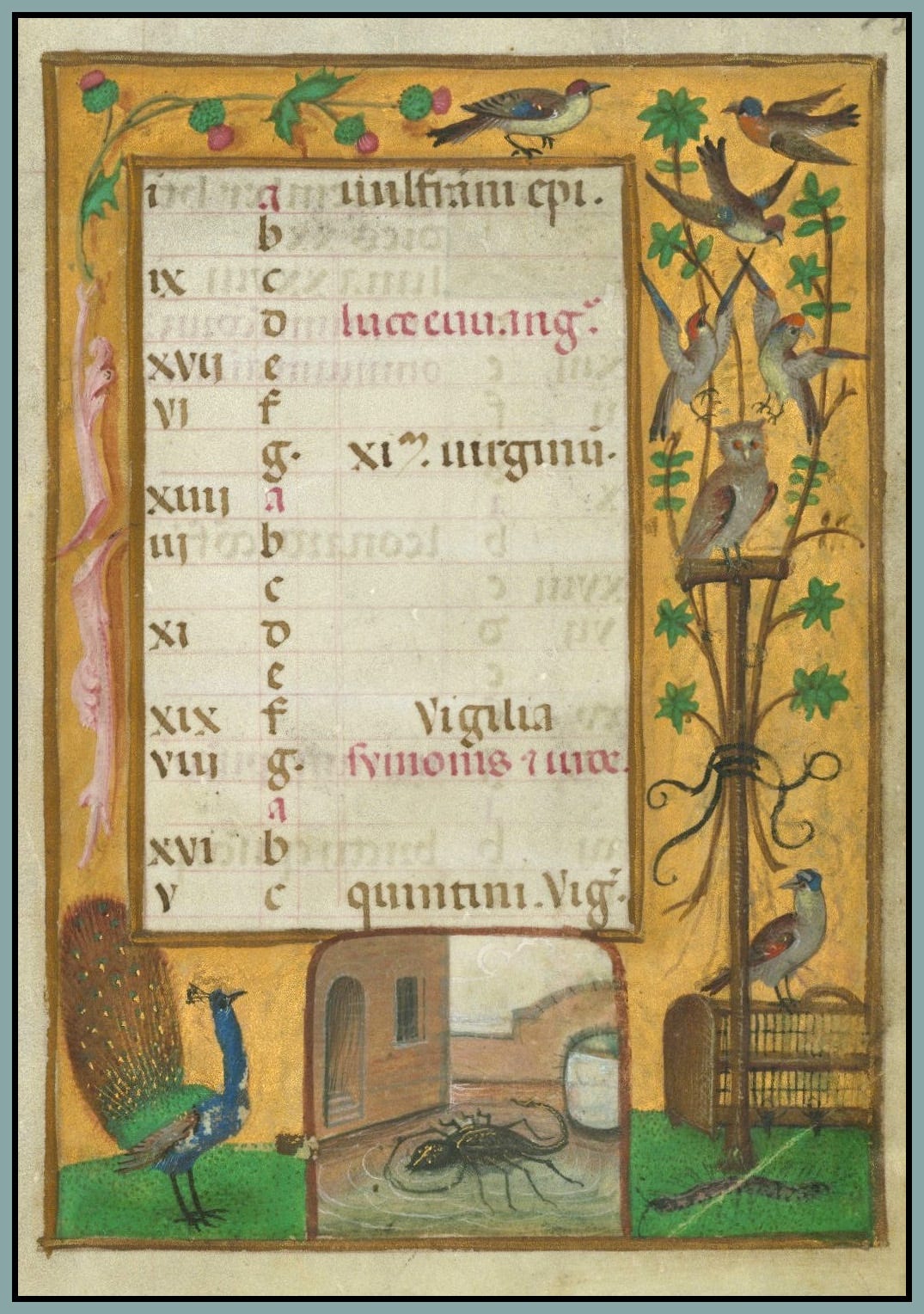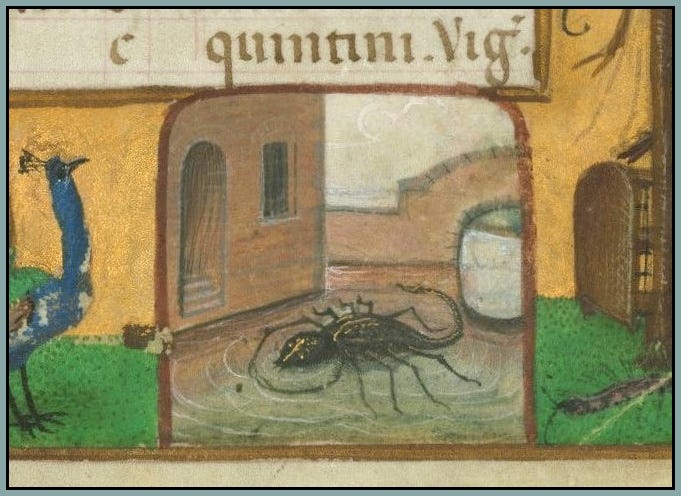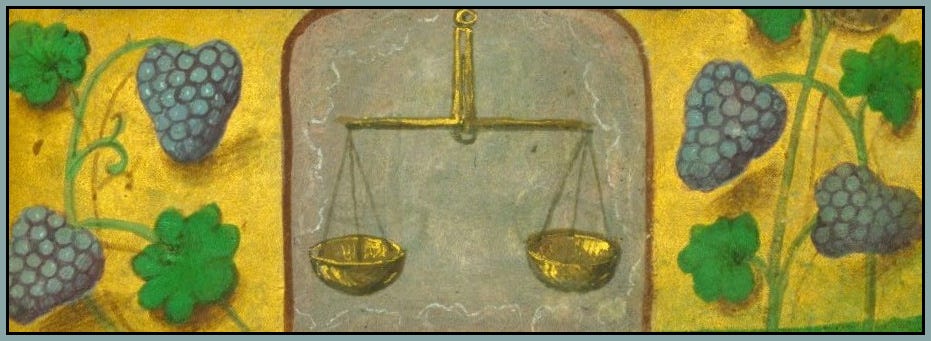The Medieval Year, a weekly feature of the Via Mediaevalis newsletter, gives us an opportunity to appreciate calendrical artwork from the Middle Ages, reflect on the basic tasks and rhythms of medieval life, and follow the medieval year as we make our way through the modern year. Please refer to the first post in this series for more background information!
It is a wonderful thing that so many modern folks are, for one reason or another, interested in and perhaps even favorably disposed toward the culture of the Middle Ages. This is no small victory for open-mindedness and critical thinking, since powerful social forces have, for quite a long time, encouraged us to adopt a very different attitude—an attitude effectively summed up by one of the official definitions for the word “medieval” in the modern English language: “exhibiting the severity or illiberality ascribed to a former age; cruel, barbarous.”
We who seek to learn from the Middle Ages do not, it would seem, perceive the era as primarily barbarous. In our view, this “illiberal” and “cruel” civilization is an extraordinary source of practical, intellectual, and spiritual wisdom—for everyone, but especially for those who find modernity outrageously incapable of answering the most fundamental questions of human life.
However—to truly learn from a distant culture, especially one that diverges so strongly from our own, we must be careful to respect the integrity of that culture. What I mean is that when studying the features of medieval civilization, we ought not celebrate those that appeal to us and then ignore the rest. This would introduce fragmentation—modernity’s speciality—into a culture that was notable and admirable for its (psychological, social, religious, and cosmological) wholeness.
I mention all this today because I want to highlight an element of calendrical art that was common and prominent, and which I have not yet discussed. I refer to the signs of the zodiac; for example:
Let’s begin with some definitions:
zodiac: “A belt of the celestial sphere extending about 8 or 9 degrees on each side of the ecliptic, within which the apparent motions of the sun, moon, and principal planets take place.”
The celestial sphere is a large, theoretical sphere in space that is concentric with the Earth. The things that we see when we look into the sky—planets, constellations, etc.—are like images projected onto the Earth-facing surface of the celestial sphere:

The “ecliptic” is a circle on the celestial sphere showing the annual path that the sun appears to take relative to the stars in the background. This path results from the orbit of the Earth around the sun, which means that the two-dimensional surface formed by the ecliptic (called the ecliptic plane) is also the Earth’s orbital plane. Because the Earth is tilted relative to its orbital plane, this path does not correspond to Earth’s equator.

If you extend Earth’s equator out into space, you create a two-dimensional surface called the equatorial plane; the circle created by the intersection of the equatorial plane and the celestial sphere is the celestial equator (as shown in the diagram). The ecliptic—which traces the motion of the sun (during the course of the year, and relative to the stars)—is offset from the celestial equator by 23.5 degrees (i.e., the tilt of the Earth’s north–south axis).
Now, imagine that there is a narrow band painted onto the interior surface of the celestial sphere, and that the band has the ecliptic as its centerline. That band is the zodiac, and it’s where “the apparent motions of the sun, moon, and principal planets take place.”
signs of the zodiac: “the twelve equal parts into which the zodiac is divided, and through one of which the sun passes in each month.” Each of these parts is associated with a constellation; their names are Aries, Taurus, Gemini, Cancer, Leo, Virgo, Libra, Scorpio, Sagittarius, Capricorn, Aquarius, and Pisces.

This diagram shows the ecliptic as a red circle, the zodiac as a band of constellations with the red circle as its centerline, and the twelve sections of the zodiac (separated by blue lines). The constellations give names to the sections of the zodiac and supply artistic representations. The twelve sections of the zodiac don’t align perfectly with the calendar months. Right around this time (October 23rd, to be precise), the sun is leaving Libra and entering Scorpio.
This brings us back to the wholeness and integrity of the medieval world. The culture of the Middle Ages speaks to us (or rather, sings to us) with many voices, and if we want these voices to bring as much richness and beauty as possible into our lives, we must recognize and remember that these voices are in harmony.
In my experience, those who take a serious interest in the medieval world are also likely to accept a fairly “modern” paradigm of human health and physiology. I am referring to a paradigm in which the body is understood in biochemical terms, studied using strictly scientific methods, and assisted through technological or pharmaceutical therapies. This paradigm proposes microscopic pathogens as a primary cause of disease and denies that health is measurably affected by undetectable energies or obscure cosmic conditions.
We must accept that this is emphatically not the paradigm that prevailed during the Middle Ages. To be sure that no one thinks I am somehow exaggerating this, I will quote verbatim (with boldface indicating my emphasis) from Dr. Irma Taavitsainen, Professor Emerita at the University of Helsinki:
“In the Ptolemaic model of the cosmos, belief in celestial influences was all-pervasive. An extensive system of correspondences formed a coherent vision linking the celestial with the terrestrial.”
“The sun and moon were especially important planets from a medical viewpoint, as the course and outcome of acute diseases could be predicted by motions of the moon, and those of chronic diseases, by the sun.”
“Another commonplace of medieval astrological medicine was the doctrine of the zodiac man (homo signorum), with man at the centre of the universe. Celestial influences from the macrocosm were reflected in the microcosm of the human body.”
“Parts of the body were governed not only by the planets, but also—and more commonly—by signs of the zodiac.”
“Astrological considerations were involved in diagnosis, prognosis, and therapy and applied to concepts of the critical days of sickness and the best times to administer medicine or carry out surgery.”
“Late medieval medical [manuscripts] reveal that astrological medicine extended from the highest levels of learning to practitioners with little or no professional training.”
This view of the human body and human health is integral to the beliefs and practices of medieval civilization, or what is often called Christendom. We don’t have to agree with it, but we should think about it. In my opinion, we should think about it very carefully. We might even imagine these two paradigms placed in a scale of spirituality and then consider which side would have more weight.













Makes sense as people usually get sick seasonally. I would be more inclined to this way of thinking as I adhere more to a ptolemaic view of the cosmos. A ball floating in space strikes me as absurd.
A question I have in regard to seasons though, what effect do you think daylight savings time has on our understanding of the cosmos? In my opinion it disorients us and makes us forget the rhymes and patterns of the seasons.
I’m not so sure anymore that the earth orbits the sun.